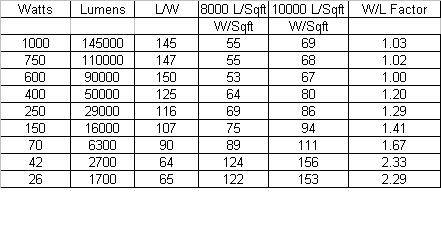G
guest 77721
The grams per watt measurement is a good indicator of personal progress or when comparing similar systems but really falls down when comparing different systems. Not all the lights put out the same intensity and the same spectrum. Comparing grams/Lumens is a better indicator.
HPS
Watts...Lumens....Lumens/Watt
1000....145000....145
750.....110000.....147
600......90000.....150
400......50000.....125
250......29000.....116
150......16000.....107
70........6300........90
CFL
42 .......2700........64
26 ...... 1700 ...... 65
If we use a 600 HPS as the standard for 50 to 65 w/sqft as optimum, it works out as 8000 to 10000 Lumens per Square Foot.
It seems that high powered HPS lights 400-1000 Watts put out similar lumens/watt but it really falls off as you get into the smaller lights. CFL's and Florescent lighting need roughly 125 to 170 w/sqft for 8000 to 10000 Lumens/sqft.
HPS
Watts...Lumens....Lumens/Watt
1000....145000....145
750.....110000.....147
600......90000.....150
400......50000.....125
250......29000.....116
150......16000.....107
70........6300........90
CFL
42 .......2700........64
26 ...... 1700 ...... 65
If we use a 600 HPS as the standard for 50 to 65 w/sqft as optimum, it works out as 8000 to 10000 Lumens per Square Foot.
It seems that high powered HPS lights 400-1000 Watts put out similar lumens/watt but it really falls off as you get into the smaller lights. CFL's and Florescent lighting need roughly 125 to 170 w/sqft for 8000 to 10000 Lumens/sqft.






